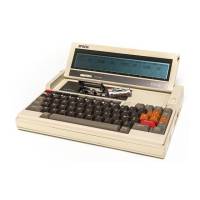3.7 The
CP/M
Built-In Commands
Built-in commands are commands which can be executed simply by typing in
their name on the command line. They do
not
show
up
as files
on
the directory
(as do STAT and
PIP,
for example)
but
are
part
of
CP/M
itself. They are:
DIR
ERA
REN
SAVE
TYPE
USER
Display a list
of
files
on
a particular disk.
Erase a specified file
or
files.
Rename a specified file.
Save a portion
of
memory as a file.
Display the contents
of
a file
on
the screen.
Assign files
to
different users
3-16
3.7.1 D
IR
(Directory)
This command
is
used to display a list
of
file names stored
on
a disk. There
are various ways
of
specifying the files depending
on
the results you want. These
are achieved using wildcards (section 3.2.1).
On
a conventional
CP/M
com-
puter the
CP/M
operating system
is
loaded into the computer from disk.
It
is not displayed
on
the directory.
It
is
also possible
to
make other files non-
directory files. This can be done in two ways. Files can be set (and reset)
to
'SYS' files using the STAT program. These files do
not
appear
on
the directo-
ry
of
any user. Files can also be assigned
to
different users using the USER
command, and then only appear
on
the directory when the particular user to
which they belong
is
using the disk.
Points worth bearing
in
mind when using the
DIR
command are:
• There must be a space between DIR and the filename (if there
is
one).
• No space must be
put
between the drive name
and
filename
if
this
is
used.
• The files are
not
sorted into alphabetical order, and are usually displayed
in the order in which they were first put
on
to the disk.
If
you require
an
alphabetical list it
i~
best
to
use the STAT command.
a) List all files
on
the currently logged-in drive
The simplest way
to
do this
is
to
type DIR
on
the command line:
C>DIR
C :
PIP
COM:
STAT
COM:
SUBMIT
COM:
XSUB COM
C : CONFIG
COM:
FlUNK
COM:
TERM
COM
The same result can be obtained by being more long-winded and using the drive-
name or wildcards:
C>DIR
C:
C >
DIR
C:???????? *
b) List all the files
on
a drive
oth~r
than
that
currently logged
in
This can be done simply by adding the required drivename to the command:
C>DIR
A:
A:
PIP
COM
3-17

